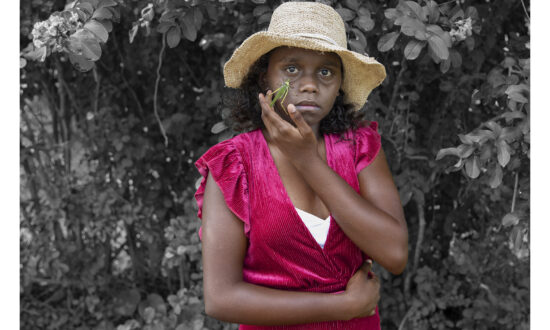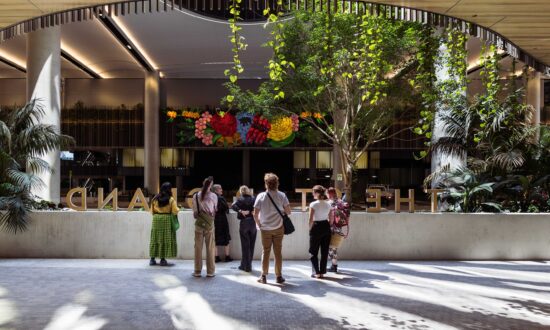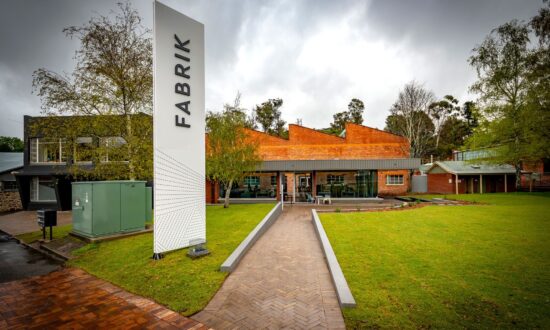Picture of the Men and Women of the World (Bankoku danjo jinbutsu zue) was created in Edo, present-day Tokyo – at that time one of the most populated and literate cities in the world – in 1861, just a few years after the opening of the nearby port of Yokohama.
The establishment of Yokohama was a momentous event, precipitated by the arrival of American steamships in 1852, demanding access to trade. For more than 250 years the Tokugawa shogunate had maintained its sovereignty by banning overseas travel by its inhabitants, as well as the building of ocean-going vessels, and severely restricting access to foreigners. Instead, they had relied upon Chinese and Dutch merchants sequestered at Nagasaki to provide access to trade and information about the world beyond the shores of the archipelago.
The proximity of Yokohama to Edo piqued the interest of curious urbanites and artists, and publishers immediately recognised a money-making opportunity, creating a wave of books, pamphlets and prints. Depictions of foreigners and their daily activities – even if they were at least in part fabricated – were the most sought-after and resulted in an estimated 400 designs between 1859 and 1862.
The new genre, known as “pictures of Yokohama” (yokohama-e) appeared at a time of significant change in the archipelago, when the age of the shogun, daimyo and samurai was coming to an end and the stage was being set for the emergence of the new modern nation of Japan.
Picture of the Men and Women of the World was created at the height of this fervour by an artist familiar with the genre and, while not specifically about the port, exemplifies the fascination with foreigners, one of the defining attributes of the Edo period (1615–1868). Woodblock print artist Yoshiiku (1833–1904) has utilised his diverse experiences creating prints of beautiful women (bijin-ga) and samurai warriors (musha-e), and stars of the kabuki stage as well as new media from overseas to fabricate this curious cast of characters.

Utagawa Yoshiiku’s Pictures of foreign men and women of all nationalities (bankoku danjo jinbutsu zu e), 1861, Edo (Tokyo), colour woodblock print; ink and colour on paper, tryptich. Gift of Shane Le Plastrier through the Art Gallery of SA 2016
The cartouche at the top of the print identifies more than 90 countries according to the names by which they were known in Japan at the time. Below the cartouche is a collection of 33 foreigners, based on pre-existing images as depicted in other media or imagined by the artist. From right to left across the bottom is a collection of European and Asian men and women.
While the culture, language and clothing of the inhabitants of East Asia were well understood, European women rarely resided in Japan. Yoshiiku has created these depictions utilising his experience with prints of “beautiful women”, which placed an emphasis on garments rather than on facial features, as well as information gleaned from Western media such as the Illustrated London News, which ran a monthly graphic devoted to the latest fashions in Paris.
At the centre is a figure dressed in a tan garment with blue-green designs, who is identified as an “inhabitant of Ezo” or an indigenous Ainu, from the northernmost island of Hokkaido, who were regarded as foreign at the time. To the left are an elegantly dressed male and female from the “Qing dynasty”, who stand in front of a member of the “Joseon dynasty”. At the far left is a “Mongol”, next to an “American”, who wears what appear to be garments popular during the 18th century.
A closer look at the top row reveals a rather intriguing collection of characters, who appear in Buddhist cosmology and the popular imagination. On the right is an inhabitant of the “land of the long-armed people”, who is complemented by his companion from the “land of long-legged people” on the opposite side. A woman from “India” holds a vase and displays an ostentatious headdress next to an inhabitant of the “land of women”. In the centre of the print a man from the “land of no abdomens” wears a grass skirt, while further to the left is a trio of men from the “land of punctured midriffs”, as indicated by the puckered holes in their chests, one even skewered by a pole. On the far left is an inhabitant from the “land of small people”, perched on a giant white elephant, gazing through a telescope.
Picture of the Men and Women of the World exemplifies a pre-occupation with foreigners in Japan throughout the Edo period. As the opportunity to interact with the world became more remote, the populace became intrigued by glimpses of the foreign, eliciting equal degrees of fascination and trepidation. The opening of Yokohama only heightened these feelings and artists like Yoshiiku adapted their varied skills to the demand.

Get InReview in your inbox – free each Saturday. Local arts and culture – covered.
Thanks for signing up to the InReview newsletter.
Utagawa Yoshiiku’s Picture of the Men and Women of the World (Bankoku danjo jinbutsu zue) is showing as part of A Vast Emporium: Artistic exchange and innovation in a global age, a new exhibition at the Art Gallery of South Australia.
Russell Kelty is Associate Curator, Asian Art, at the AGSA.
Support local arts journalism
Your support will help us continue the important work of InReview in publishing free professional journalism that celebrates, interrogates and amplifies arts and culture in South Australia.
Donate Here




